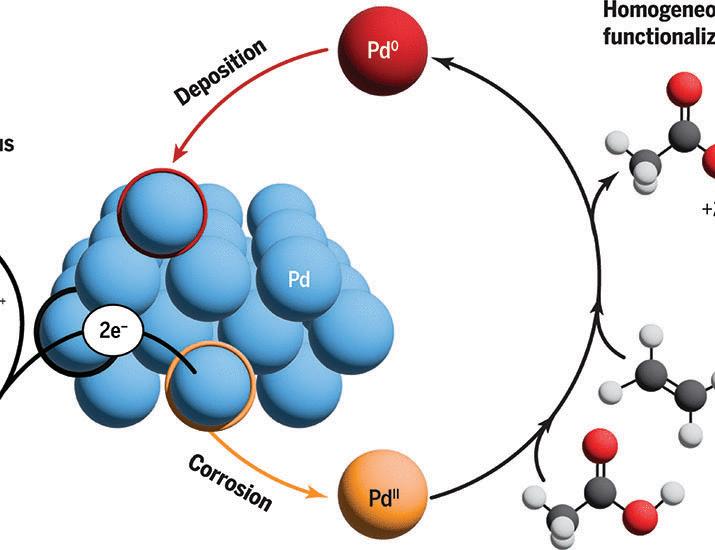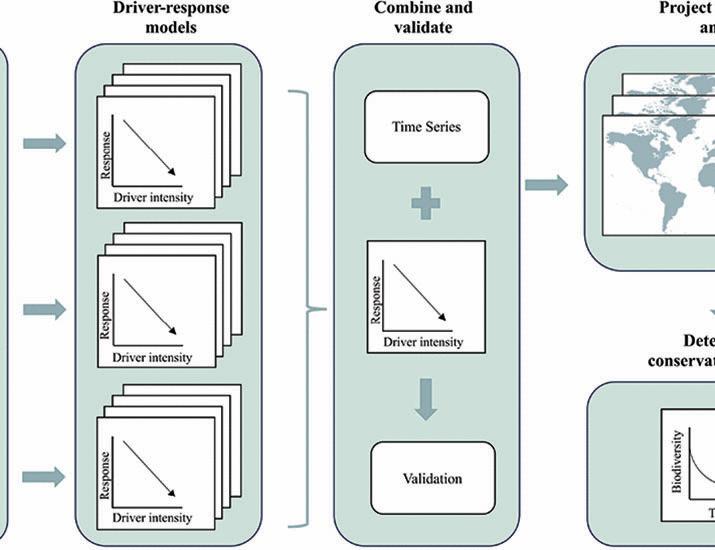Homogeneous-heterogeneous bifunctionality in Pd-catalyzed vinyl acetate synthesis | Science 4 Apr 5:01 AM (just now)
 Presently, mechanistic paradigms in catalysis generally posit that the active species remains either homogeneous or heterogeneous throughout the reaction. In this work, we show that a prominent industrial process, palladium (Pd)–catalyzed vinyl acetate ...
Presently, mechanistic paradigms in catalysis generally posit that the active species remains either homogeneous or heterogeneous throughout the reaction. In this work, we show that a prominent industrial process, palladium (Pd)–catalyzed vinyl acetate ...
Exogenous RNA surveillance by proton-sensing TRIM25 | Science 4 Apr 5:01 AM (just now)
 Exogenous messenger RNAs (mRNAs) require cellular machinery for delivery and translation but also encounter inhibitory factors. To investigate their regulation, we performed genome-wide CRISPR screens with in vitro–transcribed mRNAs in lipid ...
Exogenous messenger RNAs (mRNAs) require cellular machinery for delivery and translation but also encounter inhibitory factors. To investigate their regulation, we performed genome-wide CRISPR screens with in vitro–transcribed mRNAs in lipid ...
Integrating multiple evidence streams to understand insect biodiversity change | Science 4 Apr 5:01 AM (just now)
 Insects dominate animal species diversity yet face many threats from anthropogenic drivers of change. Many features of insect ecology make them a challenging group, and the fragmented state of knowledge compromises our ability to make general statements ...
Insects dominate animal species diversity yet face many threats from anthropogenic drivers of change. Many features of insect ecology make them a challenging group, and the fragmented state of knowledge compromises our ability to make general statements ...
Nonlinear sound-sheet microscopy: Imaging opaque organs at the capillary and cellular scale | Science 4 Apr 5:01 AM (just now)
 Light-sheet fluorescence microscopy has revolutionized biology by visualizing dynamic cellular processes in three dimensions. However, light scattering in thick tissue and photobleaching of fluorescent reporters limit this method to studying thin or ...
Light-sheet fluorescence microscopy has revolutionized biology by visualizing dynamic cellular processes in three dimensions. However, light scattering in thick tissue and photobleaching of fluorescent reporters limit this method to studying thin or ...
A geological timescale for bacterial evolution and oxygen adaptation | Science 4 Apr 5:01 AM (just now)
 Microbial life has dominated Earth’s history but left a sparse fossil record, greatly hindering our understanding of evolution in deep time. However, bacterial metabolism has left signatures in the geochemical record, most conspicuously the Great ...
Microbial life has dominated Earth’s history but left a sparse fossil record, greatly hindering our understanding of evolution in deep time. However, bacterial metabolism has left signatures in the geochemical record, most conspicuously the Great ...
Human high-order thalamic nuclei gate conscious perception through the thalamofrontal loop | Science 4 Apr 5:01 AM (just now)
 Human high-order thalamic nuclei activity is known to closely correlate with conscious states. However, it is not clear how those thalamic nuclei and thalamocortical interactions directly contribute to the transient process of human conscious perception. ...
Human high-order thalamic nuclei activity is known to closely correlate with conscious states. However, it is not clear how those thalamic nuclei and thalamocortical interactions directly contribute to the transient process of human conscious perception. ...
Geoengineering could fight climate change—if the public can be convinced 11:00 AM (5 hours ago)
 Researchers’ failures to communicate are jeopardizing even basic tests, but new projects may point the way forward
Researchers’ failures to communicate are jeopardizing even basic tests, but new projects may point the way forward
News at a glance: Star-gazing probe’s finale, African cancer database, and 2000 scientists decry Trump policies 11:00 AM (5 hours ago)
 The latest in science and policy
The latest in science and policy
Rubella and measles: The beginning of the endgame | Science 5:01 AM (11 hours ago)
 Benchmarks must be established and progress tracked to set a global target and take action
Benchmarks must be established and progress tracked to set a global target and take action
Catalysis at the crossroads | Science 5:01 AM (11 hours ago)
 Homogeneous and heterogeneous catalysis work concurrently in a chemical process
Homogeneous and heterogeneous catalysis work concurrently in a chemical process
Empower the age of smart mRNA medicine: Programmable RNA sensor and molecular tools refine therapeutic payload production | Science 5:01 AM (11 hours ago)
 Programmable RNA sensor and molecular tools refine therapeutic payload production
Programmable RNA sensor and molecular tools refine therapeutic payload production
Saving the cultural legacy of wild animals | Science 5:01 AM (11 hours ago)
 Loss of biodiversity threatens the study of tool use and other cultural behaviors in animals
Loss of biodiversity threatens the study of tool use and other cultural behaviors in animals
Dancing with the cells: How acoustically levitating a diamond enabled a redesign of biotech automation | Science 5:01 AM (11 hours ago)
 How acoustically levitating a diamond enabled a redesign of biotech automation
How acoustically levitating a diamond enabled a redesign of biotech automation
Don’t quit the long game | Science 5:01 AM (11 hours ago)
 Living cells that produce biofuel; robots that assist factory workers; intelligent machines that guide drug discovery—these technologies are “deep” in that they achieve something extraordinary—often thought impossible—and push society forward. Indeed, so-...
Living cells that produce biofuel; robots that assist factory workers; intelligent machines that guide drug discovery—these technologies are “deep” in that they achieve something extraordinary—often thought impossible—and push society forward. Indeed, so-...
Convince me, control me | Science 5:01 AM (11 hours ago)
 A historian probes the origins and evolution of psychological manipulation
A historian probes the origins and evolution of psychological manipulation
Beyond the Binary: Navigating AI’s Uncertain Future in Africa | Science 5:01 AM (11 hours ago)
 The artificial intelligence (AI) debate is increasingly polarized in Africa, mirroring a trend across the globe. On one side, utopian headlines, such as “5 Ways To Harness AI And End Poverty Forever,” claim that AI will revolutionize development. On the ...
The artificial intelligence (AI) debate is increasingly polarized in Africa, mirroring a trend across the globe. On one side, utopian headlines, such as “5 Ways To Harness AI And End Poverty Forever,” claim that AI will revolutionize development. On the ...
Science safeguards | Science 5:01 AM (11 hours ago)
 HomeScienceVol. 388, No. 6742Science safeguardsBack To Vol. 388, No. 6742 Full accessLetterNextGen Voices Share on Science safeguardsZhen Wang [email protected], Sara Shakir [email protected], [...] , Bram Servais [email protected], Safaa Osman [email protected], [...] , Yutong Hu [email protected], Yumna Gamal [email protected], Malk Elshrief [email protected], Karen Jacqueline Cloete [email pro…
HomeScienceVol. 388, No. 6742Science safeguardsBack To Vol. 388, No. 6742 Full accessLetterNextGen Voices Share on Science safeguardsZhen Wang [email protected], Sara Shakir [email protected], [...] , Bram Servais [email protected], Safaa Osman [email protected], [...] , Yutong Hu [email protected], Yumna Gamal [email protected], Malk Elshrief [email protected], Karen Jacqueline Cloete [email pro…
In Other Journals | Science 5:01 AM (11 hours ago)
 Editors’ selections from the current scientific literature
Editors’ selections from the current scientific literature
Beyond wear and tear at the joint | Science 5:01 AM (11 hours ago)
 Bile acid metabolism meets glucagon-like peptide 1 signaling in osteoarthritis
Bile acid metabolism meets glucagon-like peptide 1 signaling in osteoarthritis
Archaea go multicellular under pressure | Science 5:01 AM (11 hours ago)
 A microbe from the Dead Sea switches to a tissue-like form when compressed
A microbe from the Dead Sea switches to a tissue-like form when compressed
mRNA binding proteins join the longevity pipeline: Rebuilding muscle through the power of mRNA binding protein therapeutics | Science 5:01 AM (11 hours ago)
 Rebuilding muscle through the power of mRNA binding protein therapeutics
Rebuilding muscle through the power of mRNA binding protein therapeutics
‘Uniquely human’ language capacity found in bonobos | Science 5:01 AM (11 hours ago)
 Study is the first to show an animal combining different calls to make new meanings
Study is the first to show an animal combining different calls to make new meanings
When trainees seek other paths | Science 5:01 AM (11 hours ago)
 A new book offers advice for mentoring those who do not aspire to follow in faculty’s footsteps
A new book offers advice for mentoring those who do not aspire to follow in faculty’s footsteps
Skeletons from ‘green Sahara’ offer genetic peek at a lost human population 2 Apr 8:00 AM (yesterday, 8:00 am)
 Ancient DNA sheds light on a fleeting, lush interlude of North African prehistory
Ancient DNA sheds light on a fleeting, lush interlude of North African prehistory
Stellarators, once fusion’s dark horse, hit their stride 1 Apr 9:45 AM (2 days ago)
 Multiple companies aim to generate power by corraling plasma with twisted magnets
Multiple companies aim to generate power by corraling plasma with twisted magnets
International scientists rethink U.S. conference attendance 31 Mar 2:10 PM (3 days ago)
 Opposition to Trump administration and fears of customs run-ins are shifting travel plans
Opposition to Trump administration and fears of customs run-ins are shifting travel plans
Are terminations of NIH grants wasting billions of taxpayer dollars? 31 Mar 12:35 PM (3 days ago)
 DOGE argues killing grants saves money, but a Science analysis suggests more than $1.4 billion in sunk research costs may produce few results
DOGE argues killing grants saves money, but a Science analysis suggests more than $1.4 billion in sunk research costs may produce few results
NSF has awarded almost 50% fewer grants since Trump took office 31 Mar 11:50 AM (3 days ago)
 The reasons aren’t clear—and the agency’s director claims the president’s policies haven’t slowed grant awards
The reasons aren’t clear—and the agency’s director claims the president’s policies haven’t slowed grant awards
Saying ‘pandemic is over,’ NIH starts cutting COVID-19 research 25 Mar 2:20 PM (9 days ago)
 Grant terminations halt research on improving vaccinations and preventing future pandemics
Grant terminations halt research on improving vaccinations and preventing future pandemics
 Highlights from the Science family of journals
Highlights from the Science family of journals